A cheap play on Chinese demand
A lack of reliable data makes valuing Asian markets notoriously difficult. And without knowing what's cheap and what's not, it becomes impossible to make sensible investment decisions. Cris Sholto Heaton works out the best way to spot value in Asia, and tips one cheap way to tap in to Chinese demand.

Valuing Asia is difficult because we don't have a lot of history to work with. But we have to try we can't invest without some idea of what's cheap.
So today I'm going to look at one way of doing so. It has the advantage of using what little information we have. And it gets around some of the problems with the price/earnings (p/e) ratio.
And you might be surprised to see which Asian market stands out as cheap at the moment...
MoneyWeek
Subscribe to MoneyWeek today and get your first six magazine issues absolutely FREE

Sign up to Money Morning
Don't miss the latest investment and personal finances news, market analysis, plus money-saving tips with our free twice-daily newsletter
Don't miss the latest investment and personal finances news, market analysis, plus money-saving tips with our free twice-daily newsletter
Why price/book is a useful way to value Asian stocks
The problem with p/e ratios is that earnings fluctuate a lot with the business cycle. So it's hard to know whether current earnings are typical through-cycle averages or closer to the peak and the trough.
For the US market, Robert Shiller has developed the cyclically adjusted p/e ratio (CAPE). Alan Smithers and Stephen Wright have produced a measure called equity q based on the replacement cost of firms' assets. These help to get around this problem. (Both currently suggest the S&P 500 is around 40% overvalued.)
For emerging markets, we don't have the length and quality of data history to make this possible. The best thing we have is probably price/book (p/b) value.
Book value (also know as net asset value and shareholders' equity) is the value of a firm's assets less its liabilities. This doesn't vary as much with the cycle as earnings and so is useful for valuation.
The problem is that book value doesn't tell us much by itself (except when considering asset-based investments, such as property, or companies being bought for their break-up value). P/e is intuitive, because we know what earnings are and we can see how much we're paying for current earnings.
Book value is not so easy. To make it more meaningful, we need to consider the earning power of those assets. All else being equal, a firm that owns $10m in equipment and generates $2m in profit from them is worth more than one that generates $1m.
Our measure of earning power is return on equity (ROE), which is net income/book value. Weighing this against book value helps us assess what the p/b ratio should be.
What looks cheap and expensive in Asia
The chart below shows ROE versus p/b for most Asian markets (plus the S&P 500 and the FTSE 100 for comparison). I calculated ROE using as much recent data as I could get, which for many EMs still isn't much (as little as four years in the case of Vietnam).
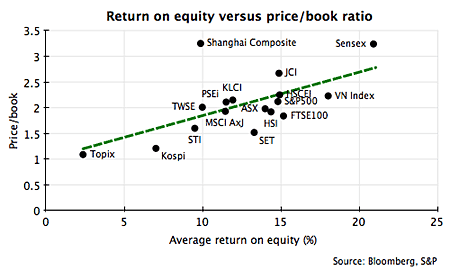
We can see that ROE and p/b are loosely related, as you'd hope, with higher ROE being rewarded with higher p/b. This doesn't tell us whether markets are cheap or expensive on an absolute basis merely how they're priced relative to each other. Broadly speaking, the higher above the green line, the more expensive they are. The lower, the cheaper.
A few points and broad trends stand out.
The mainland Chinese A share market - represented by the Shanghai Composite - is the biggest outlier and looks expensive.
India, which I have often said seems dearer than most of Asia, is above average but not egregiously so at first glance.
Compared to most of Asia, our developed-world proxies, the US and the UK, do not appear expensive. They might even be reasonably cheap.
Although Japan is often said to be one of the world's cheapest markets, it doesn't look especially so on here. The two markets that seem to be most undervalued relative to everywhere else are South Korea and Thailand.
Chinese A shares are a burst bubble, not a new one
Looking at mainland China, the overvaluation seems pretty clear cut. But I wouldn't jump to the conclusion that lax monetary policy is pushing it into a new bubble. A shares have already been in one, back in 2007 when the p/b hit a high of more than seven. What's going on today looks like a normal post-bubble pattern, with rallies and slumps continuing sometimes for many years before a bottom is finally reached.
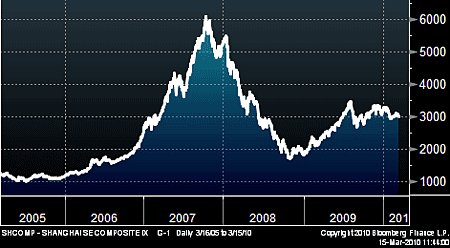
But they're certainly still expensive. To justify current valuations, A shares would have to move to a much higher level of profitability than their long-term average. But a look at the limited history shows no signs of that. ROE for the Shanghai Composite (the red line) shows no signs of a consistent upward trend.
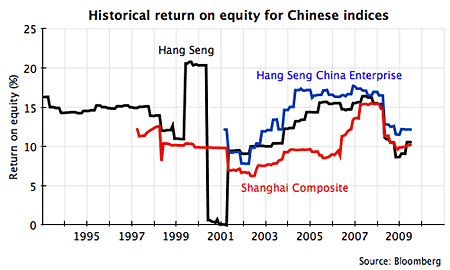
There's a big jump in returns in 2007-2008, which I think is mostly down to companies booking returns on stock investments when the market went into a bubble. That's not a sustainable source of higher profits, and ROE dropped back when both markets and the global economy slumped.
Interestingly, analysts' consensus estimates for the year ahead are some way above what we'd expect if we applied the average ROE to the current book value (about 40%-50% over). That could suggest earnings are being inflated again by firms plunging into the property sector (which is definitely bubbly in some areas).
If so, we might see a pick-up in ROE again this year and next. But it won't be sustainable, and A shares will still look pricey once it reverts to normal. There's no long-term case for investing in this market right now.
Expert tips & advice for investing in Asia! Claim your FREE guides from MoneyWeek that include:
- How to go about investing to Asia
- Which brokers to use to buy foreign shares
But few foreigners will be invested in A shares anyway. Instead, they'll mostly track the Hang Seng China Enterprises which consists of mainland Chinese firms listed in Hong Kong and the Hang Seng, which these days is roughly fifty/fifty Hong Kong firms and Chinese ones.
Neither of these indices looks out of line with average valuations. And ROE for both is in line with past trends. Analysts' consensus forecasts for these indices seem a little high, but not ridiculous.
I wouldn't be completely confident about the quality of these earnings. Lots of the firms in these indices are banks who have been lending heavily, including into construction, so I'd expect some of these loans to go bad.
And I don't especially like a lot of the firms in these indices as I discussed here, I don't think they're the kind of stocks you should be buying to get the best out of the opportunities in Asia.
But overall, I don't see much sign of a bubble in Chinese stocks when it comes to what foreigners are buying.
Can India keep profits up without debt?
Let's move on to India. India has quite a high ROE the highest on the chart. If this continues, then it looks good value. But profit growth may be slower in the next few years than over the last few.
Why? While China is only now increasing lending, India had a very strong credit cycle during the boom. Indian companies carry more debt than is typical in Asia. Credit growth may well be slower in the next few years.
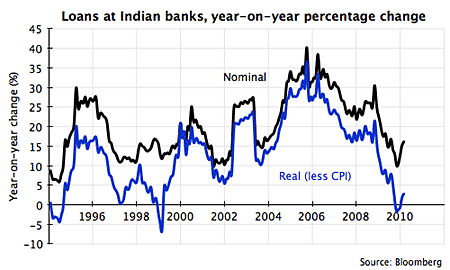
In the long run, that would probably be healthy. But it would probably also bring down ROE, since, all else being equal, you get a higher ROE by increasing your debt levels. Certainly ROE is down over the last year. Whether that's just the business cycle or the start of a deeper shift remains to be seen.
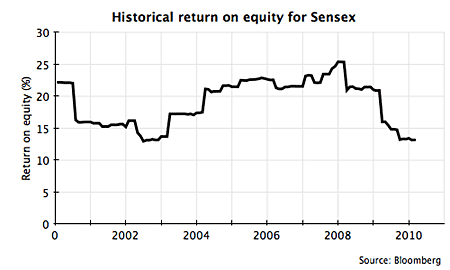
If ROE picks back up to 20%-25% quickly, India is probably cheaper than I tend to think. But for now I still reckon it's a bit pricey.
Two problems for developed markets
So why does Asia look expensive compared to developed markets? There are three possible reasons. The first is that it is. The second is that Asian ROE is understated. The third is that developed world is overstated.
When calculating the ROE, I factored out the Asian crisis of the late '90s, which hammered many Southeast Asian companies' profits. But it made little difference in most cases. The collapse was relatively brief and the recovery strong in most places. So as near as I can see, the Asian ROE is not understated.
However, it seems quite plausible that the developed world ROE has been artificially inflated in recent years. It may be much lower going forward. To test this, I looked at the long-term trend ROE for the S&P 500. As you can see, ROE fell steadily until the mid-'90s, when it spiked.
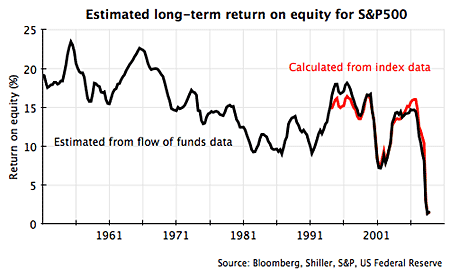
This coincided with the great leveraging-up of the US economy. This may be a coincidence, but I doubt it. If not, then a sluggish, deleveraging US economy (as we have now) may have a much lower trend ROE, making it no longer look cheap. The same trend is probably true for the UK.
The problem for developed markets is that sentiment is likely to be poor, while saver demographics are unhelpful, as I discussed last week. For this reason, I think most will suffer from the headwind of falling valuations over the next five to ten years.
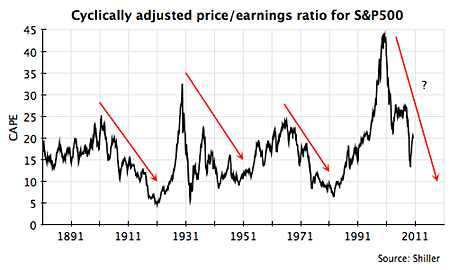
Meanwhile, sentiment and demographics should propel Asia into a cycle of rising valuations. Indeed, when Asia mania takes hold, I think there's a good chance it will peak at a much higher valuation than ever before maybe an MSCI Asia ex-Japan p/b of four or so, compared to previous peaks around three.
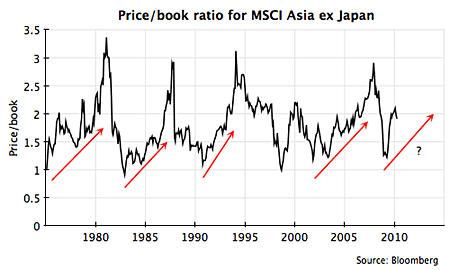
Korea is cheaper than Japan for now
Finally, Japan's appalling ROE is one explanation why it trades on such an apparently low p/b. Overcapacity and a sluggish, deflationary economy mean corporate profitability is weak.
Japan is only cheap if it has genuinely begun to emerge from the 'lost decade' and the economy is restructuring, cutting capacity, shaking off deflation and delivering higher wages and profits.
I've been a long-time believer in this restructuring story and have a fair chunk of my pension pot resting on Japan turning around. But I freely admit that my confidence in this is less strong than it once was. I still think it's likely in the long run. But as I discussed recently, I suspect Japanese shares will languish until inflation and savers are pushed to move their money out of government bonds and back into the market.
If Japanese firms successfully shake things up, ROE should rise. But don't expect it to get too high. As the chart below shows, ROE was relatively low even pre-crisis. I'd be surprised if it got back to those heights.
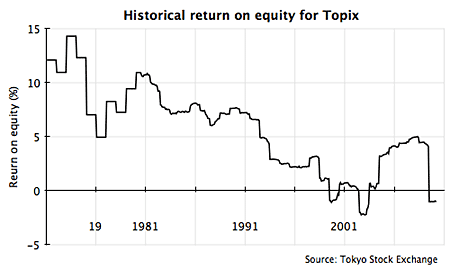
What of Korea and Thailand? Both look cheap. But I think they're cheap for a reason. Thailand shows no sign of extracting itself from its political tangles anytime soon.
And the 'Korean discount' is a long-standing phenomenon in Asian markets. This reflects the country's weak corporate governance standards and utter disregard for shareholders. Korea also has relatively high levels of debt and there are the risks associated with North Korea (including the potentially enormous fiscal cost of reunification if it eventually happens).
But there may be a tactical case for investing in Korea just now. Its exporters are benefitting from Chinese demand, helped by the weak won. So if you want a cheap shorter-term play on China, Korea is more compelling than Japan.
You could use an ETF such as the iShares MSCI Korea (LSE: IKOR). I'm not keen on the composition of the MSCI Korea, as it consists almost entirely of large business conglomerates (chaebol) that are among the worst offenders when it comes to treating shareholders badly. But if you're only trying to bet on a pick up in export-driven profits, tracking the market like this may be enough.
There's only one especially interesting alternative that I'm aware of right now, and it has a high minimum investment ($10,000). That's the Korean Smaller Companies unit trust from Asia specialist Atlantis Investment Management (+44 (0)20 7638 9192). This has strongly outperformed the Kospi since inception in 1995 (up 376% versus up 20%). Although as a small cap fund, it was inevitably hit very hard by the market collapse in 2008.
I met the fund adviser Kyueun Jeong the other week. Her strategy, which is heavily biased towards exporters, looks promising. The initial fee is 3% and the annual management fee is 1.75%. It's clearly a niche product, but might interest some readers.
I made various assumptions and used a wide range of data series in putting this data together. If you have any queries about the charts or research, do feel free to comment below.
This article is from MoneyWeek Asia, a FREE weekly email of investment ideas and news every Monday from MoneyWeek magazine, covering the world's fastest-developing and most exciting region. Sign up to MoneyWeek Asia here
Get the latest financial news, insights and expert analysis from our award-winning MoneyWeek team, to help you understand what really matters when it comes to your finances.
Cris Sholto Heaton is an investment analyst and writer who has been contributing to MoneyWeek since 2006 and was managing editor of the magazine between 2016 and 2018. He is especially interested in international investing, believing many investors still focus too much on their home markets and that it pays to take advantage of all the opportunities the world offers. He often writes about Asian equities, international income and global asset allocation.
Cris began his career in financial services consultancy at PwC and Lane Clark & Peacock, before an abrupt change of direction into oil, gas and energy at Petroleum Economist and Platts and subsequently into investment research and writing. In addition to his articles for MoneyWeek, he also works with a number of asset managers, consultancies and financial information providers.
He holds the Chartered Financial Analyst designation and the Investment Management Certificate, as well as degrees in finance and mathematics. He has also studied acting, film-making and photography, and strongly suspects that an awareness of what makes a compelling story is just as important for understanding markets as any amount of qualifications.
-
 The shape of yields to come
The shape of yields to comeCentral banks are likely to buy up short-term bonds to keep debt costs down for governments
-
 The sad decline of investment clubs – and what comes next
The sad decline of investment clubs – and what comes nextOpinion Financial regulation and rising costs are killing off investment clubs that once used to be an enjoyable hobby, says David Prosser
